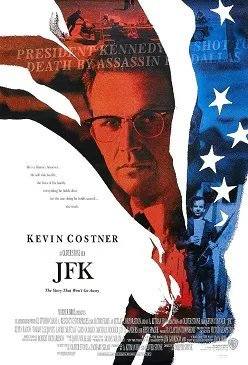Historical accuracy of JFK

Historical accuracy of JFK

Characters
Jim Garrison
Garrison was real and did conduct this investigation/prosecution. However, the film portrays him heroically, omitting criticisms of his methods and the validity of his case, which many historians and investigators dispute.
Lee Harvey Oswald
Oswald was the accused assassin. The film portrays him as a pawn ("patsy") within a conspiracy, selectively using evidence to fit this narrative, which remains a heavily debated theory.
Clay Shaw
Shaw was a real person prosecuted by Garrison and acquitted. The film portrays him as definitively involved in the conspiracy, based on Garrison's contested evidence and theories.
David Ferrie
Ferrie was a real person investigated by Garrison. The film greatly emphasizes his connections and portrays him as a key, knowing figure in the plot, which is speculative and disputed.
X (L. Fletcher Prouty)
Based on the real L. Fletcher Prouty, whose claims about a high-level conspiracy are presented largely at face value. The historical accuracy and specific details of Prouty's claims are heavily disputed by historians.
Guy Banister
Banister was a real figure investigated by Garrison. The film highlights his right-wing connections and alleged role in the conspiracy, based on Garrison's investigation, much of which is unproven or disputed.
More characters
Jack Ruby
Ruby did kill Oswald. The film implies his actions were part of the conspiracy to silence Oswald, a common but unproven theory.
Bill Broussard
Likely a composite character or based loosely on real members of Garrison's staff like James Alcock. Serves to voice doubts and act as audience surrogate.
Lou Ivon
Ivon was a real investigator who worked closely with Garrison on the JFK case.
Willie O'Keefe
O'Keefe is a fictional composite character, representing multiple unreliable witnesses Garrison used. His testimony in the film did not happen as portrayed.
Jean Hill
Hill was a real witness. The film presents her controversial account and claims of intimidation largely uncritically, while critics point to inconsistencies in her story.
Dean Andrews Jr.
Andrews was a real, eccentric lawyer. The film uses his cryptic statements ("Clay Bertrand") as key evidence, though Andrews' reliability and meaning were questioned.
Earl Warren
Warren led the commission investigating the assassination. The film portrays the commission critically, implying participation in a cover-up.
Lyndon B. Johnson
LBJ became president after JFK's death. The film strongly implies he was complicit or beneficial to the alleged coup d'état, a highly controversial and unproven claim.
Story
JFK Assassination in Dealey Plaza
The event occurred as depicted, though the film interprets the details (number of shots, trajectory) through a conspiracy lens, using analysis like the Zapruder film.
Warren Commission finds Oswald lone assassin
The Warren Commission did conclude Oswald acted alone. The film portrays this conclusion as a deliberate cover-up.
Garrison's investigation into conspiracy
Jim Garrison did launch an extensive investigation into alleged conspiracies behind the assassination in New Orleans.
Clay Shaw Trial for conspiracy
Garrison did prosecute Clay Shaw for conspiracy to assassinate JFK; it was the only such trial ever held.
Clay Shaw's acquittal
The jury acquitted Clay Shaw after deliberating for less than an hour.
Single Bullet Theory ("Magic Bullet")
The film vehemently attacks the Single Bullet Theory as impossible. While debated, the House Select Committee on Assassinations (HSCA) found it credible; the film presents only opposing views.
Oswald portrayed as a "patsy"
This is the core of Garrison's (and the film's) thesis. While many question the lone gunman theory, Oswald's role solely as a patsy is unproven and heavily debated by historians.
Involvement of CIA/Military/Anti-Castro Cubans
The film posits a wide-ranging conspiracy involving these groups. While links between some figures existed, evidence for their organized conspiracy to kill JFK is speculative and lacks proof.
X explains high-level coup rationale
Based on L. Fletcher Prouty's theories, presented as fact. Mainstream historians reject Prouty's specific claims about a planned withdrawal from Vietnam being the motive for a coup.
David Ferrie's suspicious death
Ferrie died before Shaw's trial (officially aneurysm, though ruled undetermined). The film implies he was murdered as part of the cover-up, which is speculation.
Evidence tampering/cover-up by agencies
The film alleges widespread tampering (e.g., brain missing, altered autopsy photos). While procedural issues occurred, claims of systematic, malicious tampering are largely unproven/disputed.
Garrison's methods/evidence presented
The film presents Garrison's evidence (like O'Keefe's testimony) uncritically. Critics argue Garrison used flawed methods, unreliable witnesses, and manipulated evidence.
Critique of Warren Commission procedures
The film accurately highlights some valid criticisms regarding the Warren Commission's investigation, such as limitations on access to information and certain procedural choices.
Omission of flaws in Garrison's case
The film omits significant weaknesses, contradictions, and criticisms of Garrison's investigation and prosecution of Clay Shaw, presenting his case as much stronger than it was.
Setting
Recreation of Dealey Plaza assassination
The film meticulously recreates the physical setting and sequence of events in Dealey Plaza, often blending it with the actual Zapruder film.
New Orleans atmosphere (1960s)
Captures the look and feel of New Orleans in the 1960s, including the French Quarter locations relevant to Garrison's investigation.
Washington D.C. atmosphere (1960s)
Portrays the corridors of power and intelligence agencies with a fitting visual style for the period, enhancing the conspiracy narrative.
Courtroom scenes (Shaw trial)
The courtroom setting is realistically portrayed, providing a stage for the dramatic presentation of Garrison's arguments (though the arguments themselves are disputed).
Costumes, hairstyles, vehicles (1960s)
Production design accurately reflects the fashion, cars, and general aesthetic of the early-to-mid 1960s in America.
Use of archival news footage
The film effectively integrates real news reports and historical footage (e.g., Zapruder film, Oswald interviews), blurring lines between fact and dramatization.
Depiction of investigative tools/offices
The offices and tools (files, photos, projectors) used by Garrison's team are generally representative of the era, though dramatized for effect.
Atmosphere of paranoia and cover-up
While the reasons are disputed, the film successfully creates a pervasive atmosphere of distrust, secrecy, and paranoia reflective of the post-assassination era.
